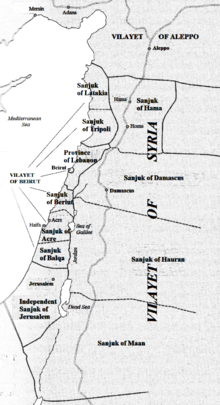Baháʼí Faith in Lebanon
The Baháʼí Faith (بهائی) has a following of at least several hundred people in Lebanon dating back to 1870.[1] The community includes around 400 people,[2] with a centre in Beit Mery, just outside the capital Beirut, and cemeteries in Machgara and Khaldeh. The Association of Religion Data Archives (relying on World Christian Encyclopedia) estimated some 3,900 Baháʼís in 2005.[3]
| Part of a series on |
| Baháʼí Faith |
|---|
 |
|
Central figures |
|
History |
|
Other topics |
History

The first Baháʼís who came to present day Lebanon were Iranians who came in the 1870s. The founder of the Baháʼí Faith, Baháʼu'lláh, was exiled to Acre, which was at the time was part of the same Ottoman province, or vilayet, of Beirut.
In 1880, Baháʼu'lláh's son ʻAbdu'l-Bahá, visited Beirut at the invitation of Midhat Pasha, the Ottoman governor of the Syria Vilayet.[4] A Beirut newspaper described his visit by saying "His Excellency, the learned, erudite, intelligent and illustrious ʻAbbas Effendi, resident of the city of ʻAkka, has arrived in our city".[4] Following the visit Baha'u'llah wrote the "Tablet of the Land of Ba (Beirut)", later described as a "glowing tribute" to ʻAbdu'l-Bahá.[4]
During his visits to Beirut, ʻAbdu'l-Bahá also met Muhammad Abduh, one of the key figures of Islamic Modernism and the Salafi movement, at a time when the two men were both opposed to the Ottoman ulama and shared similar goals of religious reform.[5][6] Rashid Rida asserts that during his visits to Beirut, ʻAbdu'l-Bahá would attend Abduh's study sessions.[7] Regarding the meetings of ʻAbdu'l-Bahá and Muhammad ʻAbduh, Shoghi Effendi asserts that "His several interviews with the well-known Shaykh Muhammad ʻAbdu served to enhance immensely the growing prestige of the community and spread abroad the fame of its most distinguished member."[8]
In 1894 a Lebanese Christian, Ibrahim George Kheiralla, converted to the Baháʼí Faith whilst traveling in Cairo. After Abdu'l-Bahá wrote a specific tablet to him, he moved to Chicago in the United States and was instrumental in converting many of the early Baháʼí followers there.[9]
Two Beirut universities - the American University of Beirut and the Saint Joseph University - had significant Baha'i student populations in the early twentieth century. The first Baha'i student was recorded in the 1890s, the “Society of the Baháʼí Students of Beirut" was formed in 1906 and by 1929 there were over 60 Baha'i students from Iran, Iraq, Egypt and Palestine. The university promoted "internationalism" as a core value and acknowledged the Baha'i students as a significant contribution to this vision. The Baha'i leader, Shoghi Effendi, studied at the American University of Beirut, graduating in 1917.[10]
A Shiʻite Imam in the southern village of Machgara, Sheikh Jaʼafar Al-Tahhan, converted to the Baháʼí Faith in 1923, and that village is now the centre of the community, with the only Lebanese local Spiritual Assembly.[1]
The Encyclopedia of the Orient reported that there were 4,000 Baháʼís living in Lebanon, or around 0.13% of the population.[11]
In 1968, a prominent Baháʼí academic, Suheil Bushrui became a visiting professor at the American University of Beirut. In the 1980s he was appointed an advisor by President Amine Gemayel, indicating how Baháʼís are accepted.[11] Bushrui is noted scholar on Khalil Gibran,[11] having published more than one volume about him[12][13] and serves as the Kahlil Gibran Chair for Values and Peace at the University of Maryland.[14][15]
Treatment
The Baha'i Faith is not one of the 18 recognised sects in Lebanon, so many Baháʼís are officially listed according to the religion of their ancestors, mostly Shiite.[11] Baháʼí marriages are therefore not recognised, so Baháʼís tend to travel to Cyprus to have a civil wedding, which is recognised when they return. Other than that, Baháʼís are allowed to practice their religion in public without any problems.[1]
References
- The Bahaʼi faith in Lebanon, Al Nahar (newspaper), 2009-09-12
- Sects And The City: The 19th Sect Of Lebanon? Archived 2012-04-08 at the Wayback Machine, Seif and his Beiruti Adventures, January 21, 2011
- "Most Baha'i Nations (2005)". QuickLists > Compare Nations > Religions >. The Association of Religion Data Archives. 2005. Retrieved 2011-02-28.
- Midhat Pasha and ʻAbdu'l-Bahá in ʻAkka: The Historical Background of the Tablet of the Land of Ba, Necati Alkan, Bahaʼi Studies Review, 2005
- Scharbrodt, Oliver (2008). Islam and the Baháʼí Faith: A Comparative Study of Muhammad ʻAbduh and ʻAbdul-Baha 'ʻAbbas. Routledge. ISBN 9780203928578.
- Cole, Juan R.I. (1983). "Rashid Rida on the Bahai Faith: A Utilitarian Theory of the Spread of Religions". Arab Studies Quarterly. 5 (2): 278.
- Cole, Juan R.I. (1981). "Muhammad ʻAbduh and Rashid Rida: A Dialogue on the Baha'i Faith". World Order. 15 (3): 11.
- Effendi, Shoghi (1944). God Passes By. Wilmette, Illinois, USA: Baháʼí Publishing Trust. p. 193. ISBN 0-87743-020-9.
- God Passes By, Shoghi Effendi, 1944
- Baháʼí Students and American University of Beirut in the Early 20th Century, Reed M. Breneman, 2008
- Lebanon: Situation of Baha'is, Government of Canada, 2004-04-16
- Gibran, Khalil (1983). Blue Flame: The Love Letters of Khalil Gibran to May Ziadah. edited and translated by Suheil Bushrui and Salma Kuzbari. Harlow, England: Longman. ISBN 0-582-78078-0.
- Bushrui, Suheil B.; Jenkins, Joe (1998). Kahlil Gibran, Man and Poet: a New Biography. Oneworld Publications. p. 55.
- Kahlil Gibran's The Prophet: Why is it so loved?, BBC News, 12 May 2012, accessed 12 May 2012
- The Kahlil Gibran Chair for Values and Peace at the Center for Heritage Resource Studies The University of Maryland Archived 2012-07-30 at the Wayback Machine
Further reading
See also
- Khalil Gibran who knew ʻAbdu'l-Bahá, head of the religion in his lifetime.
- History of Lebanon
- Religion in Lebanon